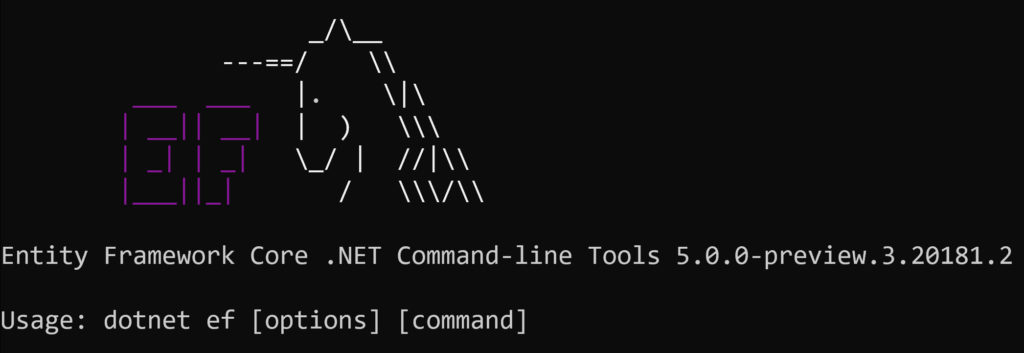Today we are excited to announce the third preview release of EF Core 5.0.
The third previews of .NET 5 and ASP.NET Core 5.0 are also available now.
Prerequisites
The previews of EF Core 5.0 require .NET Standard 2.1. This means:
- EF Core 5.0 runs on .NET Core 3.1; it does not require .NET 5.
- This may change in future previews depending on how the plan for .NET 5 evolves.
- EF Core 5.0 runs on other platforms that support .NET Standard 2.1.
- EF Core 5.0 will not run on .NET Standard 2.0 platforms, including .NET Framework.
How to get EF Core 5.0 previews
EF Core is distributed exclusively as a set of NuGet packages. For example, to add the SQL Server provider to your project, you can use the following command using the dotnet tool:
dotnet add package Microsoft.EntityFrameworkCore.SqlServer --version 5.0.0-preview.3.20181.2
The EF Core packages published today are:
- Microsoft.EntityFrameworkCore – The main EF Core package
- Microsoft.EntityFrameworkCore.SqlServer – Database provider for Microsoft SQL Server and SQL Azure
- Microsoft.EntityFrameworkCore.Sqlite – Database provider for SQLite
- Microsoft.EntityFrameworkCore.Cosmos – Database provider for Azure Cosmos DB
- Microsoft.EntityFrameworkCore.InMemory – The in-memory database provider
- Microsoft.EntityFrameworkCore.Tools – EF Core PowerShell commands for the Visual Studio Package Manager Console
- Microsoft.EntityFrameworkCore.Design – Shared design-time components for EF Core tools
- Microsoft.EntityFrameworkCore.SqlServer.NetTopologySuite – SQL Server support for spatial types
- Microsoft.EntityFrameworkCore.Sqlite.NetTopologySuite – SQLite support for spatial types
- Microsoft.EntityFrameworkCore.Proxies – Lazy-loading and change-tracking proxies
- Microsoft.EntityFrameworkCore.Abstractions – Decoupled EF Core abstractions
- Microsoft.EntityFrameworkCore.Relational – Shared EF Core components for relational database providers
- Microsoft.EntityFrameworkCore.Analyzers – C# analyzers for EF Core
- Microsoft.EntityFrameworkCore.Sqlite.Core – Database provider for SQLite without a packaged native binary
We have also published the 5.0 preview 3 release of the Microsoft.Data.Sqlite.Core ADO.NET provider.
Installing dotnet ef
As with EF Core 3.0 and 3.1, the dotnet ef command-line tool is no longer included in the .NET Core SDK. Before you can execute EF Core migration or scaffolding commands, you’ll have to install this package as either a global or local tool.
To install the preview tool globally, first uninstall any existing version with:
dotnet tool uninstall --global dotnet-ef
Then install with:
dotnet tool install --global dotnet-ef --version 5.0.0-preview.3.20181.2
It’s possible to use this new version of dotnet ef with projects that use older versions of the EF Core runtime.

What’s new in EF Core 5 Preview 3
We maintain documentation covering new features introduced into each preview.
Some of the highlights from preview 3 are called out below.
Filtered Include
The Include method now supports filtering of the entities included. For example:
var blogs = context.Blogs
.Include(e => e.Posts.Where(p => p.Title.Contains("Cheese")))
.ToList();
This query will return blogs together with each associated post, but only when the post title contains “Cheese”.
Skip and Take can also be used to reduce the number of included entities. For example:
var blogs = context.Blogs
.Include(e => e.Posts.OrderByDescending(post => post.Title).Take(5)))
.ToList();
This query will return blogs with at most five posts included on each blog.
See the Include documentation for full details.
New ModelBuilder API for navigation properties
Navigation properties are primarily configured when defining relationships.
However, the new Navigation method can be used in the cases where navigation properties need additional configuration.
For example, to set a backing field for the navigation when the field would not be found by convention:
modelBuilder.Entity<Blog>().Navigation(e => e.Posts).HasField("_myposts");
Note that the Navigation API does not replace relationship configuration.
Instead it allows additional configuration of navigation properties in already discovered or defined relationships.
Documentation is tracked by issue #2302.
New command-line parameters for namespaces and connection strings
Migrations and scaffolding now allow namespaces to be specified on the command line. For example, to reverse engineer a database putting the context and model classes in different namespaces:
dotnet ef dbcontext scaffold "connection string" Microsoft.EntityFrameworkCore.SqlServer --context-namespace "My.Context" --namespace "My.Model"
Also, a connection string can now be passed to the database-update command:
dotnet ef database update --connection "connection string"
Equivalent parameters have also been added to the PowerShell commands used in the VS Package Manager Console.
Documentation is tracked by issue #2303.
EnableDetailedErrors has returned
For performance reasons, EF doesn’t do additional null-checks when reading values from the database. This can result in exceptions that are hard to root-cause when an unexpected null is encountered.
Using EnableDetailedErrors will add extra null checking to queries such that, for a small performance overhead, these errors are easier to trace back to a root cause.
For example:
protected override void OnConfiguring(DbContextOptionsBuilder optionsBuilder)
=> optionsBuilder
.EnableDetailedErrors()
.EnableSensitiveDataLogging() // Often also useful with EnableDetailedErrors
.UseSqlServer(Your.SqlServerConnectionString);
Documentation is tracked by issue #955.
Cosmos partition keys
The partition key to use for a given query can now be specified in the query. For example:
await context.Set<Customer>()
.WithPartitionKey(myPartitionKey)
.FirstAsync();
Documentation is tracked by issue #2199.
Support for the SQL Server DATALENGTH function
This can be accessed using the new EF.Functions.DataLength method.
For example:
var count = context.Orders.Count(c => 100 < EF.Functions.DataLength(c.OrderDate));
Daily builds
EF Core previews are aligned with .NET 5 previews. These previews tend to lag behind the latest work on EF Core. Consider using the daily builds instead to get the most up-to-date EF Core features and bug fixes.
As with the previews, the daily builds do not require .NET 5; they can be used with GA/RTM release of .NET Core 3.1.
Documentation and feedback
EF Core docs has a new landing page! The main page for Entity Framework documentation has been overhauled to provide you with a hub experience. We hope this new format helps you find the documentation you need faster and with fewer clicks.
The starting point for all EF Core documentation is docs.microsoft.com/ef/.
Please file issues found and any other feedback on the dotnet/efcore GitHub repo.
Helpful Short Links
The following short links are provided for easy reference and access.
Main documentation: https://aka.ms/efdocs
Issues and feature requests for EF Core: https://aka.ms/efcorefeedback
Entity Framework Roadmap: https://aka.ms/efroadmap
What’s new in EF Core 5.x? https://aka.ms/efcore5
Thank you from the team
A big thank you from the EF team to everyone who has used EF over the years!
 Arthur Vickers
Arthur Vickers |
 Andriy Svyryd
Andriy Svyryd |
 Brice Lambson
Brice Lambson |
 Jeremy Likness
Jeremy Likness |
 lajones
lajones |
 Maurycy Markowski
Maurycy Markowski |
 Shay Rojansky
Shay Rojansky |
 Smit Patel
Smit Patel |
Thank you to our contributors!
A big thank you to the following community members who have already contributed code or documentation to the EF Core 5 release! (List is in chronological order of first contribution to EF Core 5).

 aevitas
aevitas Alaa Masoud
Alaa Masoud Aleksandar Manukov
Aleksandar Manukov Amr Badawy
Amr Badawy Anthony Monterrosa
Anthony Monterrosa Ben Brandt
Ben Brandt Ben McCallum
Ben McCallum Clarence Cai
Clarence Cai Christophe Gijbels
Christophe Gijbels Jiri Cincura
Jiri Cincura Vincent Costel
Vincent Costel Dmitry Shuvaev
Dmitry Shuvaev Eric St-Georges
Eric St-Georges Erik Ejlskov Jensen
Erik Ejlskov Jensen Christopher Davis
Christopher Davis Ivaylo Kenov
Ivaylo Kenov Jacob Foshee
Jacob Foshee Jeremy Zagorski
Jeremy Zagorski Jacob Viau
Jacob Viau Max K.
Max K. lohoris-crane
lohoris-crane Loïc Sharma
Loïc Sharma lokalmatador
lokalmatador Marius Gundersen
Marius Gundersen Roman Marusyk
Roman Marusyk Matthias Lischka
Matthias Lischka MaxG117
MaxG117 MHDuke
MHDuke Mike Surcouf
Mike Surcouf Neil Bostrom
Neil Bostrom Nícolas Michels
Nícolas Michels Obi Oberoi
Obi Oberoi Josh Studt
Josh Studt Ozan Topal
Ozan Topal Paul Middleton
Paul Middleton Raj
Raj Peter Huang
Peter Huang Rafael Almeida Santos
Rafael Almeida Santos Patrik Husfloen
Patrik Husfloen Richard Marskell
Richard Marskell sguitardude
sguitardude Sam Hobbs
Sam Hobbs Sven
Sven Vlad
Vlad vslee
vslee liweihan
liweihan Youssef Victor
Youssef Victor 1iveowl
1iveowl Thomas Levesque
Thomas Levesque Aleksander Kovač
Aleksander Kovač Leonid Tsarev
Leonid Tsarev Konstantin Triger
Konstantin Triger Ivan Maximov
Ivan Maximov Dzmitry Lahoda
Dzmitry Lahoda Bruno Logerfo
Bruno Logerfo
0 comments